
www.fairpriceseeduwa.com

Hi, Guest Welcome.
An exciting place for the whole family to shop.

In order to produce honey, bees require good nutrition and health. Bees get their sugar, mineral and carborhyrdate requirements from nectar, the sugary substance that is naturally produced by flowers. Then, just as all animals, bees also require amino acids, minerals and proteins which they obtain from plant pollen. Flower nectar is also used to make honey, whereas bees use the pollen just as food.
A small group of forager worker bees will go scouting in search of nectar and pollen. When a scout finds good foraging, she will fly back to the hive and inform other foragers where they need to go to find the source. This is done through dances, vibrations and chemical signals.
When a good foraging site has been found, the foragers fly out to collect the nectar and dip their proboscis into the flower and suck up the nectar. They store the nectar inside a pouch inside their body called a ‘honey sac’ and return to the hive. Once back at the hive, the foragers then transfer the nectar from the honey sac into the mouths of the worker bees in the hive. This adds special enzymes into the nectar which helps it turn into honey.
The worker bees then place the nectar into honeycomb cells where it changes into honey through the process of ripening. During ripening, the nectar sugars called sucrose change into honey sugars called glucose, fructose and maltose. When the honey is fully ripened, the workers cap the filled honeycomb with beeswax.
Honey is a concentrated carbohydrate solution containing a mix of simple and complex sugars. The three main sugars are Fructose, Glucose and Sucrose. Australian honeys usually contain 36-50% fructose, 28-36% glucose and 0.8-15% sucrose, depending on the floral source[1].
Preliminary studies on a selection of Australian honeys have identified considerable variation in sugar content. Honey composition is known to vary depending not only on the floral source, but also the particular season as well as other factors. An Australian honey with a relatively medium level of glucose was found to be Ironbark, [4] making this a reasonable choice if you’re looking for fast energy. Relative to sucrose, fructose is 1.2-1.8 times sweeter[1]. So, if sweetness is what you are after, then choose a honey that is rich in fructose such as Yellow Box [4]. Commercial blends generally had a lower fructose content and may not taste quite as sweet.
Due to honey being a lot sweeter compared to table sugar, a little goes a long way. This means for every one teaspoon of cane sugar, you can confidently only use ½ a teaspoon of honey and reduce your sugar intake significantly! SWEET!
In much the same way as cows make milk for their calves, bees make honey specifically for their young, so it’s got to contain more than just sugar. Honey typically contains many minor components such as organic acids, proteins, amino acids, vitamins, minerals, and polyphenols contributing to the specific aroma, color, and flavor of the honey[3]. These include:
| Avg Quantity | Per Serve | Per 100g |
| Energy | 212kJ | 1416kJ |
| Protein | 0.05g | 0.3g |
| Fat – Total | 0g | 0g |
| – Saturated | 0g | 0g |
| – Trans | 0g | 0g |
| Cholesterol | 0mg | 0mg |
| Carbohydrate | 12.5g | 83.1g |
| – Sugars* | 12.4g | 82.5g |
| Sodium | 2.3mg | 15mg |
*Sugars naturally occurring in honey.
Ingredients: 100% Pure Australian honey sourced from Eucalypt and ground flora.
Storage instructions: Store at room temperature
Based on other commercially available sweeteners we can conclude that honey, made and naturally ripened by bees, is the most natural. At Capilano, we leave it up to the bees so the process of packaging our honey is simple:
Compared to other sweeteners, Capilano honey remains a 100% natural, all Aussie sweetener with low food mileage.
Honey is sweeter on the palate than cane sugar, meaning you can use less to achieve the same great taste.

We promise to love and care for the bees that make it. To support the beekeepers that harvest it and help ensure their futures. To quality check every drop and deliver it, pure and simply to your home.
The Capilano Classic Honey range has been proudly Australian owned since 1953. Sourced from over 600 beekeeping families from across the country, we offer our customers a true, safe, and high-quality ‘hive to home’ experience.
A unique blend… our premium Classic Honey is a symphony of 100% pure, high quality Australian eucalyptus and ground flora honeys. Mild in flavour, this honey makes a perfect allrounder for the family.
Enjoy our Classic honey… as a natural sweetener, drizzled on toast, porridge and crumpets or swirled into a warm glass of water or a smoothie.
Taste… mild, golden flavour with a smooth, sweet finish.
All Capilano product are packed in PET that is BPA-free.
Capilano’s premium Australian honey is sourced from Australian beekeepers who ensure that their bees are foraging in the pristine Australian environment (largely unpopulated national parks and forests). Australia arguably has the healthiest honey bees in the world², and is largely free of the major pests and diseases seen in other honey bee populations around the globe.
Did you know, 80% of the honey produced in Australia comes from Eucalyptus trees? Capilano receives over 500 different floral sources per year during the main production season which runs from Spring to Autumn with peak production in summer. Trees flower for around 4 weeks each year and the beekeepers will move their hives to follow the tree flowering cycle. Honey is an agriculture product – trees and the bees need the right environmental conditions to produce honey.
Capilano’s 100% pure Australian Honey is made with Australian eucalypt and ground flora honeys, rich in character and flavour. These honeys consist of light and medium coloured and strong and mild flavoured honeys, which are carefully crafted together to provide a signature product with a consistently delicious flavour and colour. In times of extreme honey shortage, the colour and flavour of our 100% pure Australian honey may vary slightly due to the limited availability of Australian honey varieties available.
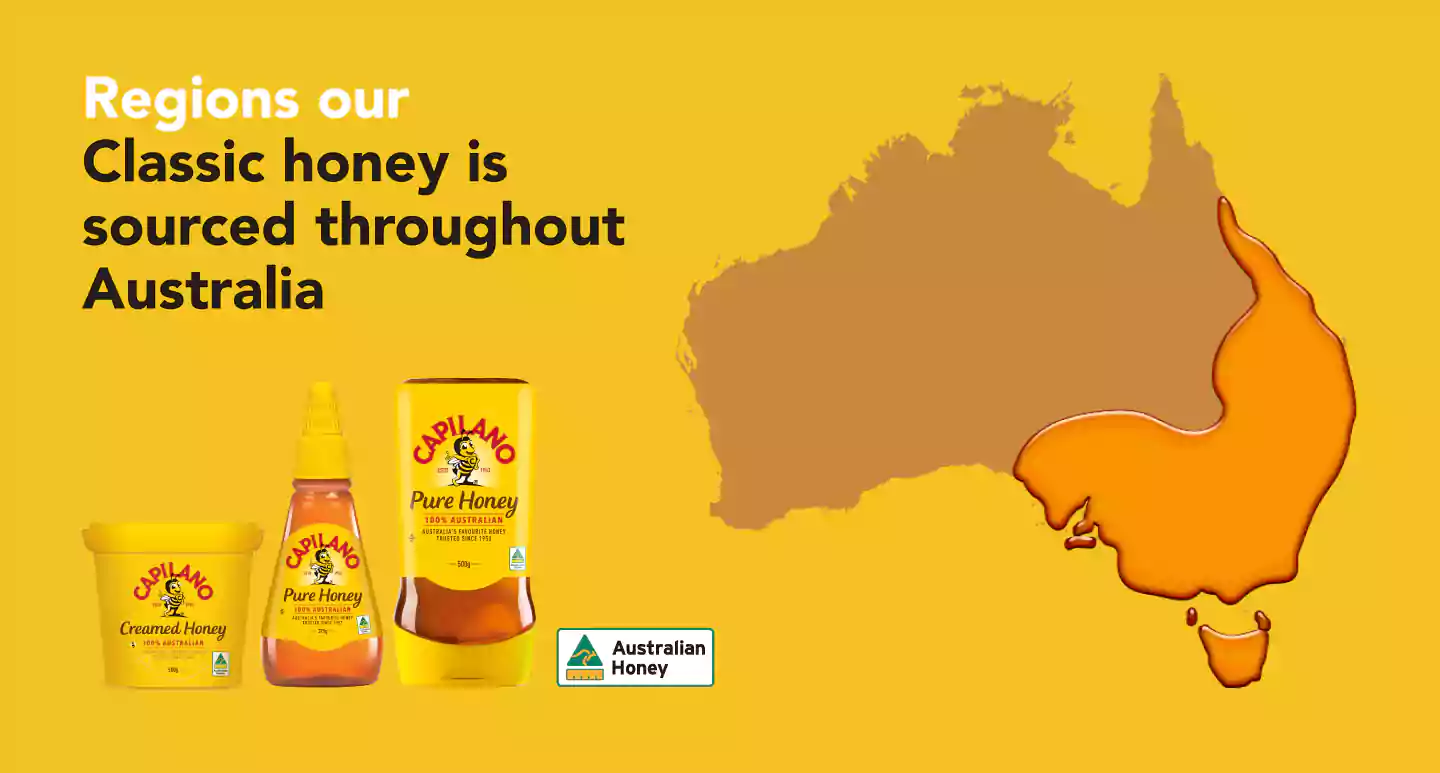

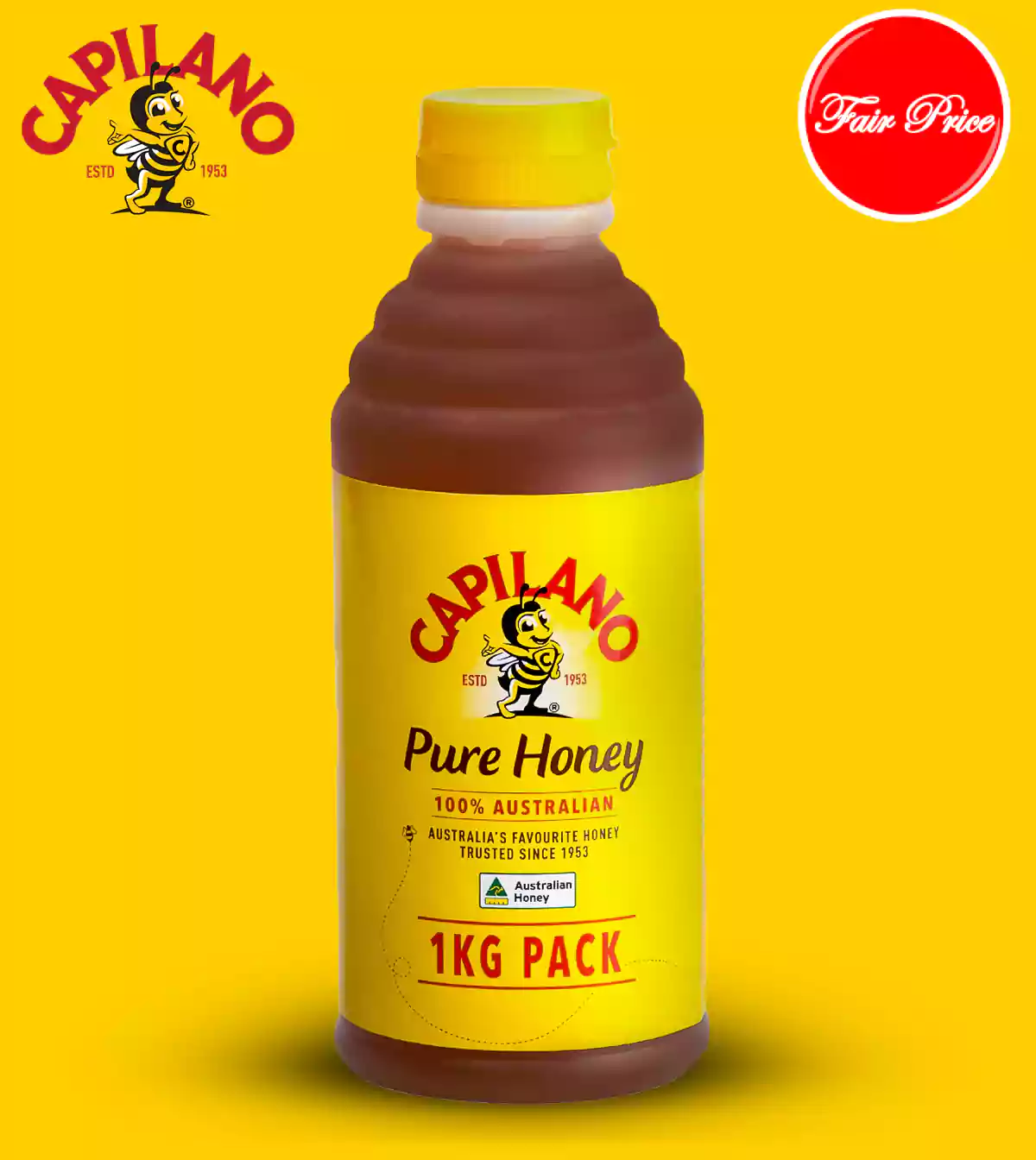
We promise to love and care for the bees that make it. To support the beekeepers that harvest it and help ensure their futures. To quality check every drop and deliver it, pure and simply to your home.
The Capilano Classic Honey range has been proudly Australian owned since 1953. Sourced from over 600 beekeeping families from across the country, we offer our customers a true, safe, and high-quality ‘hive to home’ experience.
A unique blend… our premium Classic Honey is a symphony of 100% pure, high quality Australian eucalyptus and ground flora honeys. Mild in flavour, this honey makes a perfect allrounder for the family.
Enjoy our Classic honey… as a natural sweetener, drizzled on toast, porridge and crumpets or swirled into a warm glass of water or a smoothie.
Taste… mild, golden flavour with a smooth, sweet finish.
All Capilano product are packed in PET that is BPA-free.
Recipes

Fair Price loves everything about quality products. Our mission is to provide quality products that are less costly and are affordable.
Intermediate
50 mins
8

This beautiful cake will really put a spring in your step! It is made with cannellini beans instead of butter, Capilano honey instead of refined sugar and is brimming with the rich creaminess of ricotta and toasty almond meal. A lovely cake to share with friends and family at peak strawberry season.
Ingredients
Easy
20 mins
4

Add a sweet-spicy kick to your next party or mid-week dinner with these moreish meatballs. The recipe is super flexible, simply choose your mince- pork, chicken or veal and get rolling. They’re perfect to freeze or prep ahead too!
Ingredients
Sauce
85ml (⅓ cup) rice vinegar
180g (½ cup) Capilano Pure Honey
1 tbsp soy sauce
3 tbsp tomato ketchup
2 tsp sriracha sauce
3 tbsp pineapple juice
½ tsp crushed garlic
½ tsp onion powder
1 tbsp corn flour
2 tbsp water
Meatballs
1kg minced pork or chicken
2 eggs
100g (1 cup) panko breadcrumbs
1 medium brown onion, finely chopped
Salt and pepper, to taste
2 tbsp vegetable oil, for frying.
To serve
Steamed jasmine rice
Stir-fried greens
Japanese mayonnaise
Easy
20 mins
2
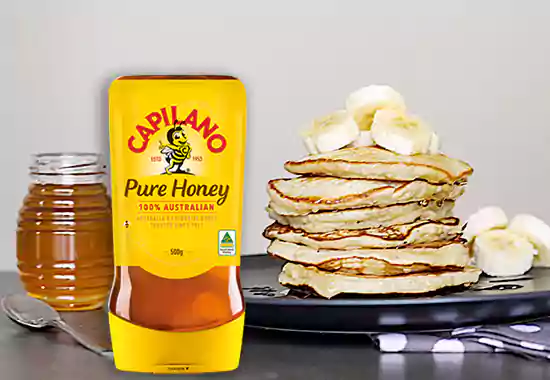
Developed by Accredited Practicing Dietitian and Accredited Nutritionist, Joel Feren, featuring the purest choice, Capilano Organic.

Ingredients
Intermediate
40 mins
4
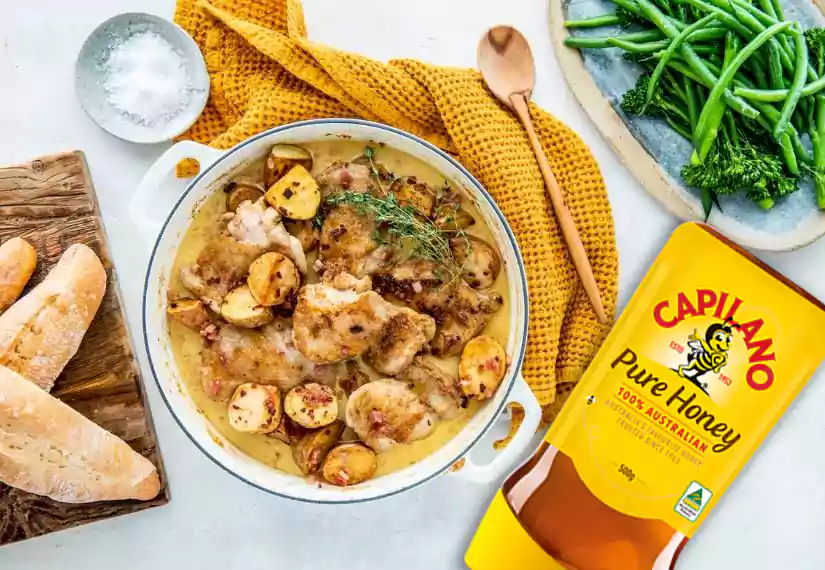
Honey Mustard Chicken and Potato Bake? It doesn’t get much better than this delicious combination to warm up on a cold winter evening.
Key equipment: Cast Iron Casserole Pot, Spray Oil, Measuring Cups
Honey Swap: 100%
Ingredients
Intermediate
1 hr 45 mins
10-12

This classic winter treat will warm you to your toes! We have recreated this family favourite to swap out the brown sugar for our honey in the cake and divine salted honey sauce.
Key equipment: Food Processor, Kitchen Scales, Spray Oil, Measuring Cups
Honey Swap: 100%
Prep-ahead tips:
• Cake can be prepared and frozen for up to 8 weeks. See how in steps below.
• Honey caramel sauce can be prepared up to 2 weeks ahead and stored in a jar in the fridge. Gently warm by standing unopened jar in warm water, or microwave for 10-20 seconds to soften before serving.
General recipe tips:
• If you don’t have a food processor, this recipe can be mixed together with hand held beaters or a stand mixer. The dates will need to be finely chopped before soaking or pureed after soaking if you can.
• It is best to follow this recipe by the grams weight, affordable kitchen scales can be purchased at most supermarkets.
• Don’t forget to use a little cooking spray or vegetable oil in your measuring cup/bowl before weighing honey into it – this helps prevent honey sticking to the cup.
• If your cake begins to brown, be sure to cover it with foil – this is just because honey browns a little quicker than table sugar.
Ingredients
150ml boiling water
180g dried pitted dates, roughly chopped
1 ½ tsp bicarb soda
100g unsalted butter
150g Capilano Pure Honey
2 tsp vanilla extract
2 large eggs
200g (1 1/3 cups) plain flour or gluten-free plain flour
1 tsp baking powder
1 ½ tsp ground ginger
½ tsp ground cinnamon
SALTED HONEY SAUCE
200g caster sugar
125g Capilano Pure Honey
2 tsp water
250g sour cream
1 tsp vanilla bean paste
50g unsalted butter, chopped
½ tsp sea salt flakes
Ice cream or Greek-style yoghurt, to serve.
Easy
5 mins
1
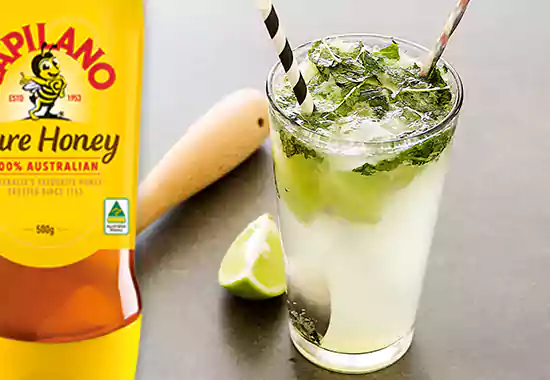
A refreshing, refined sugar free take on your classic Mojito, Developed by Accredited Practicing Dietitian and Accredited Nutritionist, Joel Feren.

Ingredients
Intermediate
1 hr + cooling
10-12
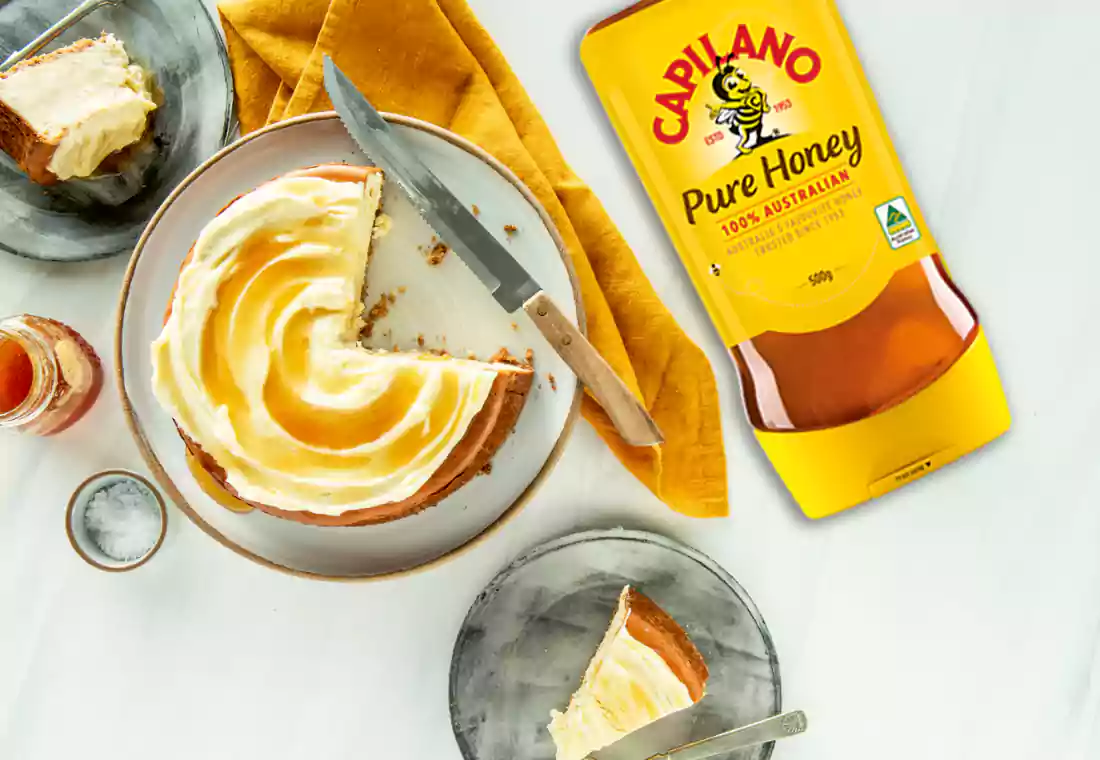
We’ve dialled up the sweet-salty factor on this iconic recipe, made with all honey instead of sugar, an irresistible salted honey drizzle and moreish gingernut biscuit base.
Prep-ahead tips:
• Cheesecake base mixture can be prepared ahead of time. Either prepare crumb mixture and chill in an airtight container for up to 2 weeks or freeze for 3 months. To prepare, warm the crumb mixture on the benchtop or in the microwave for 10 seconds to soften (if a cold day), then press into prepared tin.
• Honey sauce can be prepared up to 4 weeks ahead and stored in a jar in the fridge.
• Cheesecake can be baked and kept chilled in an airtight container for up to 3 days. Decorate with cream and honey sauce when ready to serve.
General recipe tips
• It is best to follow this recipe by the grams weight, affordable kitchen scales can be purchased at most supermarkets.
• Don’t forget to use a little cooking spray or vegetable oil in your measuring cup/bowl before weighing honey into it – this helps prevent honey sticking to the cup.
• Try to give your cheesecake time to slowly cool. If you pull it quickly from the oven, or place a warm cheesecake in the fridge, cracks may appear.
Ingredients
165g ginger nut biscuits (or gluten free sweet biscuits + 1 tsp ground ginger)
50g unsalted butter, melted
1 tsp vanilla bean paste
500g cream cheese, softened
2 tbsp plain flour (or gluten free plain)
150g Capilano Pure Honey
1 tsp vanilla extract
2 eggs, plus 1 yolk, extra
150g sour cream
TOPPING
150g sour cream (thick part only, do not over-mix)
150g Capilano Pure Honey
1 tsp lemon juice
Pinch sea salt flakes